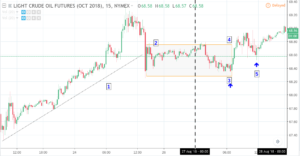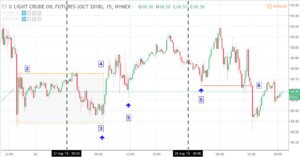Market Replay is a hypothetical study that explores how a given market might have been traded using a strict price action-based approach. Some trades might have yielded favorable results while others might have been less favorable. We reveal both.

CLV18 15-Minute Chart August 23 to 27 (August 27 shown between two vertical lines)
Trading the crude oil December contract might have been tricky as the morning hours would have landed you in the bottom range of what appeared to be a trading range.
Trading on 8/27, we would have seen the prior two trading sessions (Thursday and Friday) gave us a clear uptrend (1), only to fall into a wide sideways range (2) which took the end of the 24th and continued into the opening hours of the 26th.
By the early hours of Monday morning (the 27th) we see price bouncing off the lower limits of that range (3). Between 7am and 8am ET, we see the crude oil market picking up steam leading to a breakout above the trading range (4).
If you had entered a long position at the top of this range (2), placing a stop loss a few ticks from the bottom of (3), you would have seen markets move higher, giving you an opportunity to trail your stop as market lows moved higher (5).

CLV18 15-Minute Chart August 24 to 28 (August 27 shown between two vertical lines)
Technically speaking, there was every reason to have a bullish bias as markets moved higher to challenge the highs established on the 27th. But technical biases or setups are not always reliable predictors.
After (5), the highs failed to take out the previous session’s swing high. Instead prices began declining. The breakout at (4) failed.
If you had bought the breakout at (4) and trailed your stop to (5), you would have lost around 15-20 ticks by the time you would have been stopped out at (6).
Overall, the trade would have amounted to a loss. Despite this, however, this losing trade underscores the importance of using stops. It also demonstrates the potential advantage of trailing your stops using market-based levels (in this case, technical support levels) for stop placement.
All of the market replays are based on these basic technical analysis principles. These are not stone-set rules (technical analysis is a qualitative form of assessment and not a quantitative one) so there may be a slight degree of flexibility in interpretation.
Disclaimer Regarding Hypothetical Performance Results: HYPOTHETICAL PERFORMANCE RESULTS HAVE MANY INHERENT LIMITATIONS, SOME OF WHICH ARE DESCRIBED BELOW. NO REPRESENTATION IS BEING MADE THAT ANY ACCOUNT WILL OR IS LIKELY TO ACHIEVE PROFITS OR LOSSES SIMILAR TO THOSE SHOWN. IN FACT, THERE ARE FREQUENTLY SHARP DIFFERENCES BETWEEN HYPOTHETICAL PERFORMANCE RESULTS AND THE ACTUAL RESULTS SUBSEQUENTLY ACHIEVED BY ANY PARTICULAR TRADING PROGRAM.
ONE OF THE LIMITATIONS OF HYPOTHETICAL PERFORMANCE RESULTS IS THAT THEY ARE GENERALLY PREPARED WITH THE BENEFIT OF HINDSIGHT. IN ADDITION, HYPOTHETICAL TRADING DOES NOT INVOLVE FINANCIAL RISK, AND NO HYPOTHETICAL TRADING RECORD CAN COMPLETELY ACCOUNT FOR THE IMPACT OF FINANCIAL RISK IN ACTUAL TRADING. FOR EXAMPLE, THE ABILITY TO WITHSTAND LOSSES OR TO ADHERE TO A PARTICULAR TRADING PROGRAM IN SPITE OF TRADING LOSSES ARE MATERIAL POINTS WHICH CAN ALSO ADVERSELY AFFECT ACTUAL TRADING RESULTS. THERE ARE NUMEROUS OTHER FACTORS RELATED TO THE MARKETS IN GENERAL OR TO THE IMPLEMENTATION OF ANY SPECIFIC TRADING PROGRAM WHICH CANNOT BE FULLY ACCOUNTED FOR IN THE PREPARATION OF HYPOTHETICAL PERFORMANCE RESULTS AND ALL OF WHICH CAN ADVERSELY AFFECT ACTUAL TRADING RESULTS.
Please be aware that the content of this blog is based upon the opinions and research of GFF Brokers and its staff and should not be treated as trade recommendations. There is a substantial risk of loss in trading futures, options and forex. Past performance is not necessarily indicative of future results.